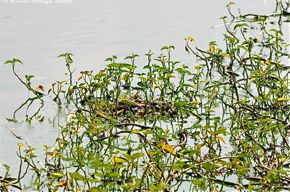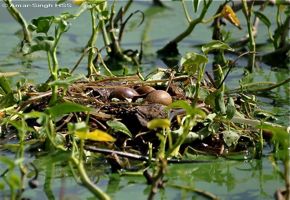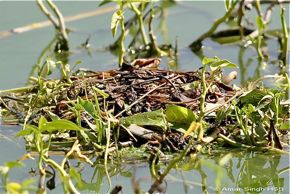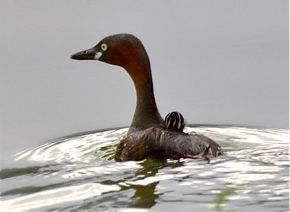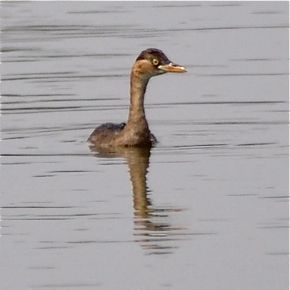The ex-mining pond near Chemor, in the Malaysian state of Perak is always popular with many water birds. These include herons, egrets, bitterns (especially Purple Heron, Ardea purpurea), Common Moorhens (Gallinula chloropus), and many Lesser Whistling-Ducks (Dendrocygna javanica). Recently, it had a surprised addition, the Little Grebe (Tachybaptus ruficollis).
Dato’ Dr Amar-Singh HSS was roaming around the area on 9th March 2010 when he came across the Little Grebe’s nest at the edge of pond. The nest was way over to the other side of the pond where there was less disturbance and more vegetation. It was hidden by a mass of probably water convolvulus (Ipomoea aquatica) or kangkong (above left).
It was mid-morning and the sun was shining bright. The eggs appeared a little discoloured (above right). The grebes could have dived into the water in a hurry as Amar approached, having no time to cover the nest. Or had the nest been abandoned?
When Amar returned on 13th March, he was relieved to find the nest carefully covered with water weeds (above left). Had it been covered during his earlier visit, he would not have detected it, so well was it camouflaged. The adults were foraging nearby but did not return to the nest during the half hour when he was observing behind some reeds. Only when he left and was at the other side of the pond did an adult return to the nest.
On 21st March, only a single egg was left on the nest. Only one juvenile was seen around, at the back of an adult (above right). The other juvenile could not be detected, probably snuggled in the back of the other adult? Did an adult with a young on its back dived into the water?
Towards the end of March tragedy struck. The entire area was cleared in the name of “agricultural development”. The plants along the edge had been cut and water weed removed from the pond. The two adults were still around but would not allow close scrutiny, thus it was not possible to check on the juveniles.
However, to Amar’s surprise, he spotted a third Little Grebe in the pond (right). It was feeding independently, so possibly could not a juvenile. Was it a non-breeding adult winter visitor? Unlike Little Grebes elsewhere, those in Peninsular Malaysia generally keep their breeding plumage right through the year (Wells, 1999). Thus any non-breeding grebes in the country are assumed to be winter visitors. Non-breeding adult winter visitors occur in the north, with two reports since the 1950s (Wells, 1999). It is suspected that these visitors are moving south, but so far south as Ipoh?
Reference:
Wells, D.R., 1999. The birds of the Thai-Malay Peninsular. Vol. I, Non-passerines. Academic Press, London. 648 pp.


